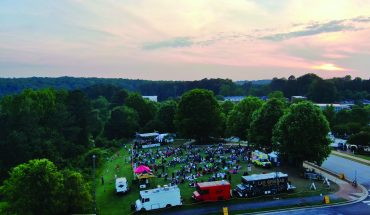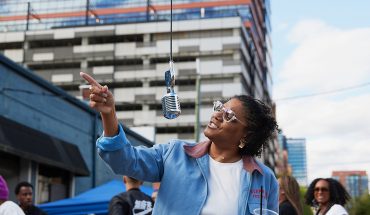by Anna Long
photograph by Michael McCloone
On most days, Darrell Markijohn practices law in Canton, Ohio. He goes home at night to his wife Hillary and their four children, and spends his leisure time training horses on their historic farm. But on March 21 and 22, Markijohn will be ducking cannonfire as he assumes his role as overall commander of Federal Troops in the 150th anniversary reenactment of the Battle of Bentonville.
“For me, the experience is quite a challenge,” Markijohn says. “It’s exhilarating as far as the actual on-field experience – to be out there commanding troops in a living re-creation of a military battle – but there are no casualties, no horrors of war, thank God.”
As the executive commander of the United States Volunteers, he has been a living historian for 20 years. Markijohn served as overall commander of Federal Troops at the 150th anniversary Bull Run, Antietam, and Chancellorsville events, among others. Even still, preparing for the Battle of Bentonville required a year of studying and logistical planning.
“We follow the military manuals on how we organize ourselves,” he says. “We are not only reenacting a battle, we are reenacting the whole military life of a nineteenth century soldier. It’s quite an endeavor.”
The battle, fought over a period of three days in March 1865, represented the last time the Confederate Army was able to mount a full-scale, tactical offensive during the Civil War. It was also the South’s only significant attempt to defeat Gen. Sherman’s vast Union army as it marched through the Carolinas that spring, and the largest land battle ever fought in our state.
Nearly 60,000 Union troops outnumbered Gen. Joseph Johnston’s weary 16,000 infantry and 4,000 cavalry as they battled on March 19, 20, and 21. On the 22nd, Johnston’s troops were forced to retreat, clearing the way for Sherman to occupy Goldsboro.
It was just one month later, on April 26, 1865, when Johnston laid down Confederate arms on Sherman’s terms at Bennett Place, a farmhouse near Durham situated between Confederate and Union headquarters. It was the largest troop surrender of the American Civil War.
Now, 150 years later, the state’s rich Civil War history is still fresh on the minds of seasoned history buffs. Some 5,000 of them – playing the parts of the Confederate and Union soldiers – hope to spark interest among a younger generation with the two-day Battle of Bentonville event.
“Every generation has its own view of the past,” says Ernest Dollar, director of the City of Raleigh Museum. Dollar will play the part of a Confederate soldier at Bentonville. “The reenactment helps people in North Carolina to remember this incredibly traumatic experience and understand how it reverberated in the state.”
The two-day Bentonville event on March 21 and 22 is the largest Civil War reenactment in North Carolina. It will also include military and civilian themed lectures and displays, house tours, Civil War merchant shops, and other special events to commemorate the 150th anniversary.
Only the battles require tickets, which are available for $12 for adults and $6 for children aged 9 to 12. For tickets and information, visit 150thbentonville.com or call 919-594-0789.




